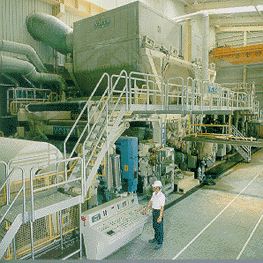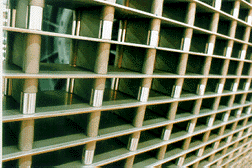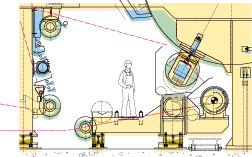|
Through-air drying has spread a long way from its home base of North America. But another technology is snapping at its heels
by Jonathan Roberts
What can beat the perforated drum?
The few through-air dryer (TAD) tissue PMs which have started up in Europe have opened up the possibility of a level of softness which was previously only demanded by North American consumers. Europeans did not rush to install TAD systems because they are expensive to install and run. They are also notoriously difficult to operate and the technology places enormous demands on the mill's winder section. This area becomes absolutely critical, because it is a waste of time creating all that bulk if it then gets lost in the winding process.
TAD is not going to take over the tissue market completely, though, as it is still a technology for top of the range products. The lighter weight grades will still depend on crescent former technology which is itself chosen for its ability to create softness. But TAD and crescent are unlikely to mix because the dryer fabric required for TAD is totally different from the felts used in crescent forming. Crescent forming has never been sold on its ability to produce higher basis weight tissue. A felt is less harsh than a wire, which is one of the main reasons why crescent formers produce such soft tissue. But rewetting can be caused by crescent formers due to the unbroken transfer on the felt and this means that speed has to be sacrificed for the production of higher basis weights. Crescent formers are popular for recycled grades because they cope better with stickies than twin-wire formers.
So TAD looks set to gain a firm foothold for producers of top end products in Europe. One notable customer is SCA Hygiene in Mannheim, Germany. It is the biggest tissue manufacturing site in Europe by volume and SCA has chosen a Valmet twin-wire TAD PM with a capacity of 200 tons/day to expand the mill's product range. The machine is due to start up in the second half of this year and will produce tissue mainly for use as kitchen towels. The PM will feature Valmet's Moister micro profiling, single-sided scanner and "an advanced reeling concept".
The crescent former is a popular choice in Asia (Photo: Tien Long, Taiwan) 
Alternative ideas
The high cost of installing and running TAD technology has generated a lot of research and development activity aimed at finding an alternative solution. Andritz/ Voith has come up with one suggestion that it claims will fulfil the softness and bulk requirements of all but the very top end of the market. The TissueFlex system involves the installation of a shoe press directly on to the Yankee. The main selling point against TAD will be cost - both of investment and running. But a shoe press also has the advantage that it can influence bulk and softness together, whereas TAD can only influence bulk and that is why calendering is essential after TAD.
The potential of the technology is clearly considerable for new PMs and rebuilds. But careful thought will have to be given before a rebuild is undertaken. The force exerted on the Yankee cylinder is likely to be between 100 N/mm and 230 N/mm. The lower figure will produce more bulk, but forces at the top end will be necessary for increased dryness. If using up to 230 N/mm, it might well be necessary to strengthen an existing Yankee cylinder. The wider the machine, the greater the likelihood that such pressures will present a problem. Of course, reduced shoe press pressure can be compensated by higher hood temperatures, but extreme hood conditions are best avoided. So TissueFlex can almost certainly increase bulk, but if it is expected to increase dryness as well, the strength of the Yankee becomes a decisive factor.
Andritz/Voith have developed a Yankee with a reinforced shell so that higher dryness as well as bulk can be achieved on wider machines. The felt will have to run almost tangentialy to the Yankee, so in a rebuild it would be necessary to adapt the suction roll to dewater the felt. The existing press roll could be used as a suction guide roll, although on a new PM it would be much easier with a simple guide roll being quite sufficient.
Andritz is responsible for marketing TissueFlex in Europe, Africa and Asia, while Voith São Paolo leads the charge in North and South America, New Zealand and Australia. Andritz has already received an order for TissueFlex from a northern European mill.
Asian preference
TAD is still virtually unheard of in Asian tissue production. A technology more likely to find favor in the Far East is on-line calendering, which is one of Celli's latest areas of progress. The company's first customer is YFY Kun Shan near Shanghai in China. The single-nip calender with hard rolls has been fitted to a Celli crescent former tissue PM with Valmet Yankee dryer. The machine started up in July and is well on the way to its design speed of 1,400 m/min.
The explanation for the Asian preference for on-line calendering is probably the higher percentage of facial tissue that the region produces compared with other tissue grades. A crescent former and calender is considered the ideal combination for facial tissue with a good hand feel. Typical is the new Toschi crescent former tissue PM which started up at Cellox Bangkok in Thailand towards the end of last year. The calender is off-line in this case and the PM will, unsurprisingly, produce facial tissue. Asia will have to experience a swing in product emphasis before TAD establishes itself in the region, but pre-pressing with some form of shoe press might emerge as a popular choice. European mills which produce facial tissue will generally use calendering, even if takes place in the converting department. On-line calendering is much more common in North America than in Europe, although this could have just as much to do with the fiber used than customer preferences - southern pine kraft, as used in the southern states of the USA, is quite coarse.
Valmet is putting its weight behind TAD. The Valmet Honeycomb division has already sold many TADs to nonwovens manufacturers, but the supplier is starting to build up a tissue customer base as well. The company has built a pilot plant for the technology at Karlstad in Sweden, which should be a valuable resource for tissue makers looking at the potential of TAD. The pilot PM features a C-wrap former and can run with a solid or suction forming roll. The headbox is 600 mm wide and the web is 550 mm at the reel. The TAD itself is just short of 5 m in diameter and there is a steam box to increase the temperature of the web.
The TAD on the pilot machine is followed by a Yankee dryer. This is standard practice, although references do exist of TADs which are not followed by Yankees. Unfortunately, the performance of such set-ups remain shrouded in secrecy, but the Yankee-free, or uncreped, TAD system is probably the next development to watch out for in TAD tissue making. Towelling would be the likely focus for such a development.
Further interesting features of the Valmet pilot machine include a closed whitewater system thanks to microflotation. Valmet has also installed dryers on the floor below the PM which allow the machine to be run as a conventional tissue PM, with crescent forming if required.
Further innovations from Valmet are expected to be announced in March at PPI's Tissue World conference and exhibition in Nice, France. Among the developments expected are new environmental technologies (including dust control), ideas for increased production levels and improvements to the industrial design of the units. Valmet is also working on a shoe press concept for tissue making in the form of pre-pressing which could be offered for grades which don't require TAD.
While you can be sure that Beloit is looking closely at shoe press applications for tissue, it is also firmly in the TAD camp. Beloit believes that TAD is the preferred technology for producers of premium tissue now and in the future. Beloit offers TAD through a deal with Fleissner, one of the fruits of which is the TAD PM just started up at AM Paper in Skelmersdale, UK. The product is expected to have three times the absorbency of standard tissue on basis weights of between 14 g/m and 25 g/m.
Toschi freely admits it is working on the shoe press concept. The company believes that all major tissue technology suppliers will have this technology within the next few years. Toschi has a particular interest in the shoe press because it is a technology which could work with the modular tissue machine - something close to Toschi's heart. Through-air drying is expensive, no question about it, and buyers of modular tissue machines want to manufacture tissue on a budget. But the shoe press, while an additional cost, offers the potential of speed and quality which is likely to prove highly attractive to the typical buyer of the modular tissue machine - the converter that wants to expand vertically to ensure reliable jumbo roll supply.
It appears that the modular tissue machine is also finding favor with some of the major tissue manufacturers. Toschi claims that major tissue producers in the USA, China and Mexico are looking seriously at its Modulo modular tissue PM. According to Toschi, these as yet unnamed players are drawn by the speedy startup and low investment cost. The next startup of a Modulo is due shortly at a more typical client - a small tissue manufacturer in Argentina.
Differences in customer requirements worldwide are decreasing year by year and as the number of suppliers drops, so technology becomes ever more international in its application. The delivery of the first complete Valmet tissue machine to Japan is something of a landmark in this respect. The 6 m wide, 2,000 m/min machine will be the widest and fastest tissue PM in Japan. And China can no longer be viewed as the country of countless machines with tiny capacities. The Beloit PM that is due to start up at Vinda Xinhiu in China this year has a design speed of 2,200 m/min. At 2.7 m wide and with 35,000 ton/yr capacity it might not be a monster, but the layered headbox, crescent former machine would be welcome in any tissue mill around the world.
Through-air drying is yet to gain a firm foot-hold in Europe (Photo: Fleissner) 
Into additives
Of course tissue softness is not just achieved by mechanical means. Chemical technology is vital to ensure proper adhesion between the Yankee cylinder and the tissue, for instance, which is essential for creping uniformity, doctor blade protection, heat transfer, protection from corrosion and, of course, speed. Then there are coating modifiers which help control adhesion, improve bulk/caliper, increase stretch and ensure a uniform coating performance. Cylinder conditioners help extend the life of the Yankee as well as allowing for longer production runs, improved coating film formation and optimized distribution of fillers on the Yankee. Other chemical essentials include release agents, debonders and softeners.
Hercules' new tissue program, ProSoft, is broken into five technologies which between them cover all the above functions. But the name makes it clear what Hercules perceives to be the tissue maker's main target. ProSoft is part of what Hercules calls its 'Total Tissue Process Management System', which includes monitoring software and sensors to control the application of its new chemical technologies.
Post PM
What happens after the PM is crucial to tissue manufacturing productivity and there has been some progress in post-PM technology. For example, Celli has developed a technology to wind jumbo reels on cardboard cores. An expanding shaft is inserted inside the cardboard core. When the jumbo roll is finished, it is moved to an unloading station where the expanding shaft is extracted automatically. Then the shaft can be inserted into a new core. The idea is to simplify handling by reducing the requirement for spool shafts and allowing jumbo rolls to be stored on cardboard cores.
Further down the line, coordination and efficiency is just as important. According to Pulsar of Italy, the primary cause of poor production rates in converting is ineffective transport and exchange of rolls between the log saw and wrapping machines. Rolls are often damaged in this phase by the divider system or they arrive upside down. Avoiding such hiccups requires constant supervision by machine operators.
Pulsar claims to have solved the problem with its Roll Exchange Divider System (REDS), a solution already tried by the Sofidel group which has installed the system at its Delipapier plant in France. REDS is an intelligent exchanging and dividing transport system which interfaces electronically and mechanically the log-saw and wrapper. Pulsar says it makes possible a transport and exchange rate of 300 rolls/min/channel, which makes the most of the fastest log-saw machines on the market (1,200 rolls/min for a log-saw machine with four channels).
The latest Tissueflex technology 
Getting dusty
Whatever the technology being used, one of the main issues in tissue making is dust control. This is a bigger problem in tissue making than in the production of any other grade. The tissue machine room air system tends to trap air and set up an airflow pattern which just recirculates dust. Dust from the dry end of the machine ends up in places where operators are subject to maximum exposure.
There are three levels of dust control. Dust can be controlled at source, it can be contained so that it does not reach production areas or it can be kept out of sensitive areas using displacement technology.
A development from Jagenberg typifies the measures established by suppliers to control dust at source. Jagenberg has brought out a compact roll trimming machine for tissue. Known as Vari-Soft II, it is distinguished by the way it is completely encapsulated. With improved suction facilities, this should lead to much improved dust control.
A development from BTR Environmental fits into and third level of dust control technology. The DCE 2000 series comprises units in 14 size options which use reverse jet cleaning filtration technology with automatic integral control. They use the downflow air principle and are designed to provide filtration of dust in air volumes of up to 6,500 m/hour. Efficiencies better than 99.99% are claimed.
According to Valmet Dust Control and Tissue Systems, the prime suspect for dust creation in the tissue mill is the creping doctor. The company explains that primary dust control is not 100% effective here, so measures must be put in place to prevent the dust from reaching production areas. But even the best former exhaust system cannot capture all the vapors, so a false ceiling is built over the wet end.
At the dry end, a modern canopy hood tightly encloses the dust-generating area. But the sheet still has to enter and leave and operators still require access, so complete dust containment is nigh on impossible.
Dilution systems act to dilute contaminated air with fresh air and dust is still distributed throughout the working area. This is where tertiary dust control comes in by establishing a moving wall of ventilation air which results in controlled air patterns in the building. Displacement modules initiate the delivery of air around the periphery of the machine room and provide the wall which prevents re-entrainment of contaminated air.
Heat and vapor in the machine room create natural air flows which tertiary control uses. Tertiary dust control means a cleaner workplace and better machine hygiene. Good working practices tend to bring wide-ranging benefits. Reduced clean-up times and fewer shutdowns from hygiene problems are the obvious ones, but the health of operators should be a primary concern whether or not it is legislated.
In the years to come, it is likely that machine room exhaust will be treated in more and more countries as a process exhaust, in which case separating equipment will not just be desirable, it will be necessary for compliance.
|